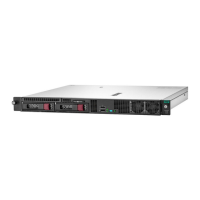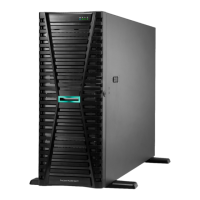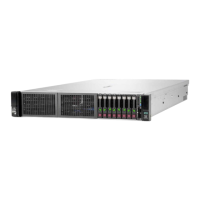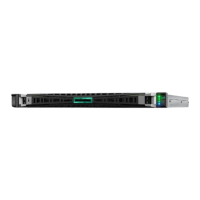BIOS/Platform Configuration Options
Workload Profiles and performance options
Workload Profiles is one of the HPE Intelligent System Tuning (IST) features and allows you to tune the
resources in your HPE ProLiant server by choosing a preconfigured workload profile. The server will
automatically configure the BIOS settings to match the selected workload.
System provided Workload Profiles
The system provides these Workload Profiles:
General Power Efficient Compute
This profile is the default profile for most ProLiant servers and HPE Synergy compute modules.
This profile applies the most common performance settings that benefit most application workloads
while also enabling power management settings that have minimal impact to overall performance.
The settings that are applied heavily favor a balanced approach between general application
performances versus power efficiency.
This profile is recommended for customers that do not typically tune their BIOS for their workload.
General Peak Frequency Compute
This profile is intended for workloads that generally benefit from processors or memory that must
achieve the maximum frequency possible, for any individual core, at any time. Power management
settings are applied when they ensure that any component frequency upside can be readily achieved.
Processing speed is favored over any latencies that might occur. This profile is a general-purpose
profile, so optimizations are done generically to increase processor core and memory speed.
This profile benefits workloads that typically benefit from faster compute time.
General Throughput Compute
This profile is intended to be used for workloads where the total maximum sustained workload
throughput is needed. Increased throughput does not always occur when the processor runs at the
highest individual core speed. Increased throughput can occur when the processor is able to perform
sustained work across all available cores during maximum utilization. Power management settings
are disabled when they are known to have impact on maximum achievable bandwidth.
Best throughput is achieved when the workload is also (Nonuniformed Memory Access) NUMA aware
and optimized so settings that benefit NUMA awareness are applied.
Virtualization - Power Efficient
This profile is intended to be used for virtualization environments. The profile ensures that all available
virtualization options are enabled. Certain virtualization technologies can have possible performance
impacts to nonvirtualized environments and can be disabled in other profiles. Power management
settings can have an impact on performance when running virtualization operating systems and this
profile applies power management settings that are virtualization friendly.
Virtualization - Max Performance
This profile is intended to be used for virtualization environments. The profile ensures that all available
virtualization options are enabled. Power management settings are disabled in favor of delivering
maximum performance.
Low Latency
This profile is intended to be used by customers who desire the least amount of computational latency
for their workloads. This profile follows the most common best practices that are documented in the
44 BIOS/Platform Configuration Options

